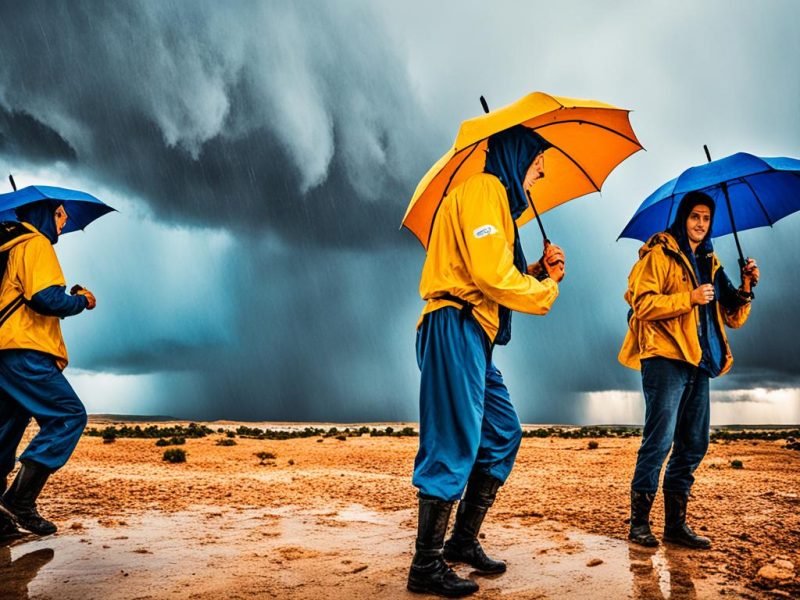Did you know Tunisia is one of the driest in the Mediterranean? It gets less than 400mm of rain each year. The country has a mixed climate. This is because of its spot between the Mediterranean Sea and the Sahara Desert. So, the weather changes a lot from one place to another.
There’s a big difference in climate across the country. The coast enjoys mild, rainy winters but has hot, dry summers. Yet, the south near the Sahara is much drier and very hot in summer. Learning about Tunisia’s rain can help pick the best time to go. It’s useful if you like the sun more than cool, rainy weather.
Key Takeaways:
- Tunisia receives less than 400mm of rainfall annually.
- Weather patterns are influenced by both the Mediterranean Sea and the Sahara Desert.
- There are significant regional variations in climate.
- Coastal areas have more rainfall compared to inland and desert regions.
- Understanding precipitation in Tunisia helps in planning your visit.
Introduction to Tunisia’s Climate
Tunisia’s climate is a mix of Mediterranean touches and local changes. This mix affects the country’s weather, making it vary from green coasts to dry deserts in the south.
Overview of Mediterranean Influences
The north coast of Tunisia enjoys a Mediterranean feel. Hot, dry summers and mild, wet winters are common. The Mediterranean Sea helps to keep the Tunisian Climate Rainfall even, which is good for crops and nature.
Variations Across Different Regions
Yet, move away from the coast and things change. The south has a semi-desert to desert climate with little rain and high heat. Near the coast, rain is moderate but far south, it’s much less. This leads to less green, rough areas.
Understanding these area changes helps us get the full picture of Rainy Season Tunisia and its effect on Tunisia’s varied lands.
Weather Patterns in Tunisia
Everyone should know about Tunisia’s weather. It changes a lot through the year.
Temperature Fluctuations
Temperatures in Tunisia go up and down a lot. In January, it’s usually between 6 °C and 16 °C. By July, it often reaches 33 °C. This shows how varied Tunisia’s climate is. It’s shaped by the sea and the desert.
Seasonal Changes
The weather in Tunisia changes with the seasons. From June to September, it’s mostly sunny with little rain. From October to April, it’s cloudier with more rain. This pattern is important for farming and water in Tunisia.
Knowing these changes helps plan things better. It’s all about finding a balance between dry and wet weather here.
When Does It Rain In Tunisia?
Knowing when it rains in Tunisia helps if you’re visiting. The rain changes with seasons and areas. From September to April is when it usually rains.
Rainy Season Timeline
Rain falls mainly from September to April in Tunisia. Data shows a big jump in rain during these months. But in summer, especially July, it hardly rains at all. October sees the most rain, about 23 mm in two days.
Monthly Breakdown of Rainfall
Rainfall in Tunisia changes month by month. Here’s a look at the average rain, using Tunisian data:
| Month | Average Rainfall (mm) |
|---|---|
| January | 17 mm |
| February | 18 mm |
| March | 19 mm |
| April | 14 mm |
| May | 9 mm |
| June | 2 mm |
| July | 0 mm |
| August | 4 mm |
| September | 10 mm |
| October | 23 mm |
| November | 21 mm |
| December | 18 mm |
Tunis Weather Forecast Rainfall
I’ve noticed something interesting about the weather in Tunis. The city sees different amounts of rain during the year. It gets about 485 millimetres of rain annually. But in summer, the rain really slows down. This creates a special pattern of weather.

Annual Rainfall Data
The yearly rain data for Tunis shows more rain in some seasons than others. The rain in Tunisia is influenced by Mediterranean weather. So, it doesn’t rain the same in every month.
| Month | Average Rainfall (mm) |
|---|---|
| January | 63 |
| February | 56 |
| March | 45 |
| April | 38 |
| May | 35 |
| June | 11 |
| July | 2 |
| August | 7 |
| September | 37 |
| October | 67 |
| November | 52 |
| December | 72 |
Peak Rainy Months
The rainiest months in Tunis are from autumn to early spring. During this time, precipitation in Tunisia is at its highest. If you’re visiting, prepare for wet weather. This rainy season affects when to best see the city’s sights.
Rainfall in Coastal Regions
Tunisia’s coast has a special climate that is different from the inland areas. The Tunisian Climate Rainfall varies a lot because of the Mediterranean sea. Cities like Tunis and Sousse enjoy this climate, making them lovely places all year.
The rainy season in Tunisia happens mainly in late autumn and winter. This time brings lots of rain that helps plants along the coast grow. You can see how the Rainy Season Tunisia changes the coast through weather data and the thriving nature.
This table shows how much rain falls in some coastal cities each month. It shows the different amounts in the Tunisian Climate Rainfall.
| Month | Tunis (mm) | Sousse (mm) |
|---|---|---|
| January | 67 | 51 |
| February | 59 | 45 |
| March | 50 | 39 |
| April | 41 | 29 |
| May | 26 | 21 |
| June | 12 | 10 |
| July | 3 | 2 |
| August | 7 | 5 |
| September | 35 | 29 |
| October | 65 | 52 |
| November | 75 | 61 |
| December | 70 | 56 |
Rain Patterns in Inland and Desert Areas
The Inland Tunisia Climate and Desert Climate Rainfall are quite different from the coast. Inland and desert areas get very little rain. This makes life tough for animals and people there.
In desert towns like Tozeur and El Borma, rain is really rare. They get between 60 mm and 95 mm of rain a year. This small amount of rain makes the desert a rough place. The temperature can change a lot in one day because the air is so dry.
Now, let’s look closely at the Inland Tunisia Climate. We’ll compare it with Desert Climate Rainfall:
| Region | Annual Rainfall (mm) | Temperature Range (°C) |
|---|---|---|
| Tozeur | 60 – 95 | 5 – 48 |
| El Borma | 60 – 95 | 5 – 48 |
In Inland Tunisia, the temperature varies a lot through the seasons. Even so, it doesn’t rain much. Even in the winter, which should be wetter. This shows how the area’s geology and climate create tough but unique ecosystems.
Tunisian Climate Rainfall Statistics
The study of Tunisia’s rainfall stats shows how the country’s weather behaves.
Historical Data
In the past, Tunisia’s weather split rainfall evenly. The north got more rain, moving southward, it drops. Places like Bizerte and Tabarka get lots of rain. This is due to the Mediterranean climate.
Recent Trends
Lately, Tunisian rain data has stayed steady despite global climate changes. This keeps the weather predictable. Both locals and visitors can make plans without worry.
Here’s how historical and recent rain data compare, showing steadiness:
| Region | Historical Average (mm) | Recent Average (mm) |
|---|---|---|
| Bizerte | 600 | 605 |
| Tabarka | 640 | 635 |
| Tunis | 470 | 465 |
This data proves Tunisia’s weather stays pretty much the same, year after year.
Impact of Rain on Travel Plans
When you plan a trip to Tunisia, it’s key to know how rain might change your plans. Many wonder if the weather will mess up their fun. Learning about Tunisia Travel Weather lets tourists enjoy their visit, even when it rains.
Best Time for Tourists
The best time to visit Tunisia is in spring (March to May) and autumn (September to November). The weather is nice then, and everything looks beautiful. While summer is great for the beach, it might rain a lot. To stay dry, avoid going during the rainy months.

Precautions During Rainy Season
In the rainy season, autumn and winter, it’s smart to be ready. Pack things like raincoats and shoes that keep water out. Also, be ready in case travel gets delayed. Knowing the best time to visit Tunisia and the Tunisia Travel Weather really helps make your trip better.
How to Prepare for Rainy Weather in Tunisia
Getting ready for Tunisia’s rainy days needs thinking ahead and smart packing. Our Tunisia Packing Guide helps you stay prepared. It makes your journey nicer too.
Packing Essentials
- A durable, water-resistant jacket.
- Comfortable water-resistant shoes.
- Light layers for fluctuating temperatures.
- Quick-dry clothing and accessories.
- Travel-sized umbrella and waterproof bags.
Choose these things for comfort and use while you travel. Watch the weather closely. Change your packing as needed.
Choosing Accommodation
Choosing the right stay is key. It should be comfy and handy on rainy days. Look for places with:
- Indoor recreational facilities such as gyms, pools, and spas.
- Proximity to indoor attractions like museums, theatres, and galleries.
- Services like laundry to dry wet clothes.
- Reliable transportation options to navigate wet weather.
When planning your trip, follow these Travel Tips Tunisia. They help make your visit smooth and fun, even with rain.
Regional Differences in Rainfall
The Tunisia Regional Climate shows us a world of contrasts. In the north, there’s more rain thanks to the Mediterranean climate. But go to the south, and it’s much drier, nearly a desert.
To see how different it is, let’s look at rainfall in the north and south. Here’s a table with the numbers:
| Location | Region | Average Annual Rainfall (mm) |
|---|---|---|
| Tunis | North | 450 |
| Bizerte | North | 558 |
| Sousse | Coastal | 300 |
| Tozeur | South | 100 |
| Tataouine | South | 80 |
Look at the table, and you’ll see the difference. Places like Tunis and Bizerte get more rain than Tozeur and Tataouine. This shows how weather patterns affect the land and its resources.
The understanding of Tunisia Regional Climate and weather patterns is crucial for planning purposes, agriculture, and managing natural resources effectively.
Long-term Weather Trends in Tunisia
Looking at Tunisia’s weather over time is really interesting. The north usually gets some rain, unlike the dry south. But now, Tunisia Climate Change is shaking things up. This change is big and could really affect the weather.
Keeping an eye on Weather Forecast Tunisia shows ups and downs we need to study. Both old and new data show changes worth looking into.
| Region | Historical Rainfall (mm) | Recent Rainfall (mm) | Temperature Variation (°C) |
|---|---|---|---|
| Northern Tunisia | 500-800 | 450-700 | 1-2 rising |
| Southern Tunisia | 50-150 | 30-100 | 2-3 rising |
This table shows us how weather is changing. In both north and south, there’s less rain now. Plus, it’s getting warmer. This highlights how important Tunisia Climate Change is. It will really impact Weather Forecast Tunisia in the future.
“The changing climate dynamics in Tunisia are a reflection of global environmental shifts, requiring proactive strategies to mitigate adverse effects.”
We must keep watching these trends. It’s vital to take steps that deal with Tunisia’s changing climate.
Conclusion
Knowing when it rains in Tunisia is key for visitors wanting a great trip. You need to plan well because the weather changes depending on where you are. This makes sure you have fun and stay comfy in this wonderful country.
Tunisia’s weather changes a lot from the coast to the desert. By looking at rainfall data, you can guess the weather for your trip. This helps you pick the best time to go.
Looking at Tunisia’s weather trends helps plan your trip. With the right advice, you can enjoy Tunisia’s old places, fun culture, and lovely nature. It doesn’t matter when you decide to visit.







